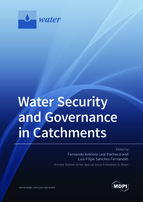Water Security and Governance in Catchments
A special issue of Water (ISSN 2073-4441). This special issue belongs to the section "Water Resources Management, Policy and Governance".
Deadline for manuscript submissions: closed (31 December 2021) | Viewed by 50704
Special Issue Editors
Interests: groundwater management; groundwater contamination risk; water–rock interactions; groundwater flow modeling; groundwater–surface water interactions; land degradation and surface water quality; spatial decision support systems in public water supply planning; conjunctive use of water resources; water security
Special Issues, Collections and Topics in MDPI journals
Interests: flood-detention basins; rainwater harvesting for drought effects attenuation; hydrologic modeling at the catchment scale; water resources management; quality data; integrated monitoring of climate and environmental impacts; sustainability in agri-food and forestry ecosystems
Special Issues, Collections and Topics in MDPI journals
Special Issue Information
Dear Colleagues,
Water scarcity, water pollution, and extreme events are increasing environmental and human health problems that require thorough attention worldwide. Taking the watershed as a representative unit for water management, the topic of water security and governance has become hot in the few past years and is now prominent in the political agenda of many countries. The concerns about water security are usually fourfold: (1) the continuous changing mosaic of water shortage related to the balance between availability and the access and demand for ever more water; (2) flooding (coastal, river, flash or glacier outburst floods), encompassing the causes, development, and impacts of flood events, as well as mitigation and restoration measures; and (3) the human dimensions of water security in relation to conventional (surface water and groundwater) and alternative (wastewater and desalination) sources. The discussion covers the multiple standpoints, such as politics, economics and finance, access, social equity, ethics, risk, adaptation, ecosystem services, and nexus challenges, among others; and (4) the vulnerability of water supply systems, assessed through relationships between public health and the quality, quantity, and reliability of the systems, as well as the public-health impacts of wastewater management and re-use.
The purpose of this Special Issue is therefore to bring scientists into a discussion on water security and governance and their implications to urban and rural supply of public water, as well as the prevention and mitigation of floods. .
Thank you very much for your contributions.
Prof. Dr. Fernando A.L. Pacheco
Prof. Dr. Luís Filipe Sanches Fernandes
Guest Editors
Manuscript Submission Information
Manuscripts should be submitted online at www.mdpi.com by registering and logging in to this website. Once you are registered, click here to go to the submission form. Manuscripts can be submitted until the deadline. All submissions that pass pre-check are peer-reviewed. Accepted papers will be published continuously in the journal (as soon as accepted) and will be listed together on the special issue website. Research articles, review articles as well as short communications are invited. For planned papers, a title and short abstract (about 100 words) can be sent to the Editorial Office for announcement on this website.
Submitted manuscripts should not have been published previously, nor be under consideration for publication elsewhere (except conference proceedings papers). All manuscripts are thoroughly refereed through a single-blind peer-review process. A guide for authors and other relevant information for submission of manuscripts is available on the Instructions for Authors page. Water is an international peer-reviewed open access semimonthly journal published by MDPI.
Please visit the Instructions for Authors page before submitting a manuscript. The Article Processing Charge (APC) for publication in this open access journal is 2600 CHF (Swiss Francs). Submitted papers should be well formatted and use good English. Authors may use MDPI's English editing service prior to publication or during author revisions.
Keywords
- soil degradation
- water pollution
- watershed, remote sensing
- management







